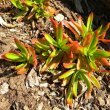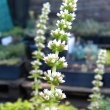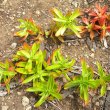| Botanical Name |
Crassula capitella - Campfire |
| Family |
Crassulaceae - The crassula family. |
| Pronunciation |
KRASS-yoo-la kap-ih-TEL-uh |
| Common Name(s) |
English: Campfire crassula
|
| Plant Group |
- Succulent A plant having fleshy stems or leaves often adapted to dry conditions.
|
| Plant Size |
- Small
| Tree | 4m to 8m |
| Shrub | 50cm to 75cm |
| Perennial/ground cover | 10cm to 20cm |
| Bulb | 20cm to 30cm |
| Succulent | 10cm to 20cm |
|
| Position |
- Light or Dappled Shade Found below trees with sparse, open foliage. Ideal for the protection of herbaceous plants.
- Partial Shade The area is in shade for part of the day and in full sun for part of the day.
- Sun The area is in full sun for all or most of the day, all year round.
|
| General Information |
- Drought Tolerance: High The plant is well adapted to arid conditions; it can survive long periods of drought and high temperatures without extra water.
- Evergreen Plants that have leaves all year round.
- Frost: Half-hardy The plant is able to survive low temperatures and some frost but requires protection against severe frost.
- Sand tolerant Plants adapted to survive in nutrient poor, very sandy soils.
- Water Wise Plant species originating from low rainfall regions that require less water to survive and thrive than other plant species.
|
| Specific Information |
The Campfire crassula is a branching succulent with fleshy propeller-like leaves that mature from bright lime green to bright red. Leaves turn bright red if not over-watered and the plant receives direct sun for most of the day, during drought or in cold temperatures. It has a prostrate habit, forming mats about 15 cm tall and up to a meter wide. It does best in partial sun and requires more shade in hotter inland sites. When grown in shade, the leaves are bright apple green for most of the year. Although fairly drought tolerant along the coast, it requires regular irrigation inland. In cold climates where there is danger of frost, plant in a container, so it can be moved into a protected area during very cold weather.
This species is also often listed as a cultivar of Crassula erosula or Crassula subacaulis ssp. Erosula.
|
| Ad Break |
|
| Flowers |
| Description |
tiny star flowers on a tall, stout stem
|
| Season |
- Summer Plants will seldom bloom for the entire season as given in the list, but should flower during a period within these parameters.
|
| Colour |
|
| Growth Rate |
- Moderate to Fast Specifying growth rate can be very misleading as there is considerable variation of growth rate depending on type and species of plant, available water, supplementary feeding, mulching and general care, as well as the plants suitability and adaptability to the garden environment.
|
| Plant Uses |
- Attracts bees, butterflies or other insects This plant attracts insects which can be food for birds or other creatures in your garden.
- Border A strip of ground, at the edge of a driveway or path in which ornamental plants or shrubs are planted.
- Container Trees, shrubs and ornamental species that can adapt to growing in a restricted environment.
- Edging A low growing plant that provides softness or definition to the edges of a bed or walkway.
- Filler Either a fast growing tree or shrub used temporarily to fill in an area while the permanent plants grow to a desired size, or a plant used to fill gaps in borders or beds.
- Foliage Plant Plants grown because their foliage is colorful or unique. Many of these plants have insignificant flowers.
- Ground Cover Low-lying plants that spread fast, require minimal maintenance, and cover large expanses or bare areas between bulbs or shrubs. They provide protection from erosion and drought and improve the visual appearance of the garden.
- Pot Plant A plant that needs a protected environment on a patio or indoors.
- Rock Garden An area constructed of larger rocks, arranged naturally, to emphasise the use of stones as a main element. Generally plants used do not need a lot of care.
- Suitable for coastal gardens Plants adapted to dry, sandy soil, forceful wind, limited rainfall and intense sunlight.
- Wild Garden An indigenous garden planted for the benefit of wildlife and birds. Provides food, water, a variety of mini-biomes and no poisonous chemicals are used.
|
| Distribution and Habitat |
south-eastern Namibia, central KwaZulu-Natal, southern Free State, central arid and semi-arid areas of the Western Cape, extending into dryer parts of high rainfall areas, absent from the south-eastern parts of the Eastern Cape Province, in a wide range of habitats, usually sheltered by either rocks or other plants
|
| Planting Suggestions |
Plant in light or porous, well-drained garden soil. Use compost sparingly and only if the soil is very impoverished, or this crassula will not keep its shape or colour. Water thoroughly when soil is dry to the touch, especially during the first growing season to establish a deep, extensive root system. Protect from frost to prevent scarring. As with many crassulas, it deteriorates after flowering which is a good time to prune and replant. For a neat appearance, remove old foliage before new leaves emerge. Divide clumps every 2 to 3 years in early spring. Propagate from root, stem or leaf cuttings in spring or summer. Over watering, a humid environment or poor drainage may result in powdery mildew, fungal leaf spots, stem rot and root rot.
|
| Medicinal Uses |
|
| Ad Break |
|







Comments
Crassula capitella
Hi
I had a few of these growing in my garden until December/January came along and with it slugs and millipedes. These two wonderful creatures demolished my Crassula capitella over a couple of nights.
I have dug the plants up, potted them and placed them in my shade house, where they are slowly recovering. I have since then been going out at night and collecting hundreds of millipedes and a lot fewer slugs and in the morning relocate them to a small forest area by my tennis club.
Kind regards
Jeanette
Slugs and millipedes
Hi Jeanette
Glad to hear you were able to get rid of your pests without the use of poison - a good way of targeting only the unwanted critters and allowing the rest of the garden underworld to go about their business.
I also have had problems with millipedes, snails and slugs with some of my succulents and, like you, go out at night and collect them for re-location. It really is the best way to get rid of them. A couple of years ago I had a snail invasion of epic proportions. I went out with my torch every night for about two months and estimate that I collected well over a thousand of the pests. But it was worth it: I have seen very few snails in my garden since then and the birds seem to keep the population under control. I must admit though, that I did not relocate them but collected them in tins and poisoned them as this species is not indigenous to South Africa and I did not want to encourage them to breed in the veld.
On the other hand, I also have two or three tortoises that are very partial to juicy succulents and chomp their favourite cotyledons to the ground, while crushing anything else in their path as they lumber through my beds. I can't even consider re-locating them as I feel honoured to have them in my garden.
I guess we can't win them all.
Kind regards
Lorraine
Slugs and millipedes
I love that you have tortoises, awesome. Sad for your succulents.
Would you possibly have a picture of the non-indigenous slug? I have seen and collect 4 different varieties and would be most interested to know which are "good" and which are "bad".
I am glad that I am not the only one who relocates the little night creatures, my hubby and his friends think I am quite mad!!!.
Hi Jeanette
Hi Jeanette
I am afraid I know very little about slugs. All I can suggest is that you visit the following site where you can see photos of many kinds of slugs, most of which are indigenous: http://www.ispotnature.org/search/node/slugs
I am amazed at the number of different slugs there are!
Kind regards
Lorraine
Crassula campfire
These are doing very well for me, and I read that you need to cut off the flowers or else the plant will die. Is that true for you? Also, can I propagate it from the flower stalks I do cut off? It is very easy to propagate, actually, but I was wondering about those flower stalks. Thanks
Crassula campfire
Oh, thank you for answering. I love talking about plants. I am very excited about the crassula campfire. Small plantlets are even growing from holes in the large decorative rocks I have in my front yard. These plants just seem to be spreading like wildfire, and it is wonderful. I have taken off the little platelets and started new ones in small pots. In the shade, the plants are green, and in the sun, red. Carol
Discuss this plant
Share knowledge, ask a question or give an experience.